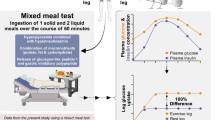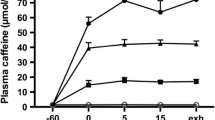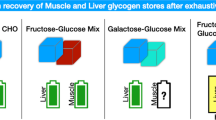Abstract
Highly endurance-trained athlete’s heart represents the most extreme form of cardiac adaptation to physical stress, but its circulatory alterations remain obscure. In the present study, myocardial blood flow (MBF), blood mean transit time (MTT), oxygen extraction fraction (OEF) and consumption (MVO2), and efficiency of cardiac work were quantified in highly trained male endurance athletes and control subjects at rest and during supine cycling exercise using [15O]-labeled radiotracers and positron emission tomography. Heart rate and MBF were lower in athletes both at rest and during exercise. OEF increased in response to exercise in both groups, but was higher in athletes (70 ± 21 vs. 63 ± 11 % at rest and 86 ± 13 vs. 73 ± 10 % during exercise). MTT was longer and vascular resistance higher in athletes both at rest and during exercise, but arterial content of 2,3-diphosphoglycerate (oxygen affinity) was unchanged. MVO2 per gram of myocardium trended (p = 0.08) lower in athletes both at rest and during exercise, while myocardial efficiency of work and MVO2 per beat were not different between groups. Arterial levels of free fatty acids were ~twofold higher in athletes likely leading to higher myocardial fatty acid oxidation and hence oxygen cost, which may have blunted the bradycardia-induced decrease in MVO2. Finally, the observed group differences in MBF, OEF, MTT and vascular resistance remained significant also after they were controlled for differences in MVO2. In conclusion, in highly endurance-trained human heart, increased myocardial blood transition time enables higher oxygen extraction levels with a lower myocardial blood flow and higher vascular resistance. These physiological adaptations to exercise training occur independently of the level of oxygen consumption and together with training-induced bradycardia may serve as mechanisms to increase functional reserve of the human heart.





Similar content being viewed by others
References
Baumgartner H, Hung J, Bermejo J, Chambers JB, Evangelista A, Griffin BP, Iung B, Otto CM, Pellikka PA, Quinones M (2009) Echocardiographic assessment of valve stenosis: EAE/ASE recommendations for clinical practice. J Am Soc Echocardiogr 22:1–23. doi:10.1016/j.echo.2008.11.029
Binak K, Harmanci N, Sirmaci N, Ataman N, Ogan H (1967) Oxygen extraction rate of the myocardium at rest and on exercise in various conditions. Br Heart J 29:422–427. doi:10.1136/hrt.29.3.422
Bing RJ, Siegel A, Vitale A, Balboni F, Sparks E, Taeschler M, Klapper M, Edwards S (1953) Metabolic studies on the human heart in vivo. I. Studies on carbohydrate metabolism of the human heart. Am J Med 15:284–296. doi:10.1016/0002-9343(53)90082-5
Breuer HW, Skyschally A, Schulz R, Martin C, Wehr M, Heusch G (1993) Heart rate variability and circulating catecholamine concentrations during steady state exercise in healthy volunteers. Br Heart J 70:144–149. doi:10.1136/hrt.70.2.144
Camici PG, Olivotto I, Rimoldi OE (2012) The coronary circulation and blood flow in left ventricular hypertrophy. J Mol Cell Cardiol 52:857–864. doi:10.1016/j.yjmcc.2011.08.028
Duncker DJ, Bache RJ (2008) Regulation of coronary blood flow during exercise. Physiol Rev 88:1009–1086. doi:10.1152/physrev.00045.2006
Ferguson S, Gledhill N, Jamnik VK, Wiebe C, Payne N (2001) Cardiac performance in endurance-trained and moderately active young women. Med Sci Sports Exerc 33:1114–1119. doi:10.1097/00005768-200107000-00008
Gertz EW, Wisneski JA, Neese R, Houser A, Korte R, Bristow JD (1980) Myocardial lactate extraction: multi-determined metabolic function. Circulation 61:256–261. doi:10.1161/01.CIR.61.2.256
Gledhill N, Cox D, Jamnik R (1994) Endurance athletes’ stroke volume does not plateau: major advantage is diastolic function. Med Sci Sports Exerc 26:1116–1121. doi:10.1249/00005768-199409000-00008
Grubbstrom J, Berglund B, Kaijser L (1991) Myocardial blood flow and lactate metabolism at rest and during exercise with reduced arterial oxygen content. Acta Physiol Scand 142:467–474. doi:10.1111/j.1748-1716.1991.tb09181.x
Haskell WL, Sims C, Myll J, Bortz WM, St Goar FG, Alderman EL (1993) Coronary artery size and dilating capacity in ultradistance runners. Circulation 87:1076–1082. doi:10.1161/01.CIR.87.4.1076
Heinonen I, Nesterov SV, Liukko K, Kemppainen J, Nagren K, Luotolahti M, Virsu P, Oikonen V, Nuutila P, Kujala UM, Kainulainen H, Boushel R, Knuuti J, Kalliokoski KK (2008) Myocardial blood flow and adenosine A2A receptor density in endurance athletes and untrained men. J Physiol 586:5193–5202. doi:10.1113/jphysiol.2008.158113
Heiss HW, Barmeyer J, Wink K, Hell G, Cerny FJ, Keul J, Reindell H (1976) Studies on the regulation of myocardial blood flow in man. I.: training effects on blood flow and metabolism of the healthy heart at rest and during standardized heavy exercise. Basic Res Cardiol 71:658–675. doi:10.1007/BF01906411
Heusch G (2012) Reprint of: the paradox of alpha-adrenergic coronary vasoconstriction revisited. J Mol Cell Cardiol 52:832–839. doi:10.1016/j.yjmcc.2011.12.010
Heusch G, Baumgart D, Camici P, Chilian W, Gregorini L, Hess O, Indolfi C, Rimoldi O (2000) Alpha-adrenergic coronary vasoconstriction and myocardial ischemia in humans. Circulation 101:689–694. doi:10.1161/01.CIR.101.6.689
Holtz J, Mayer E, Bassenge E (1977) Demonstration of alpha-adrenergic coronary control in different layers of canine myocardium by regional myocardial sympathectomy. Pflugers Arch 372:187–194. doi:10.1007/BF00585335
Huang SC, Barrio JR, Yu DC, Chen B, Grafton S, Melega WP, Hoffman JM, Satyamurthy N, Mazziotta JC, Phelps ME (1991) Modelling approach for separating blood time-activity curves in positron emission tomographic studies. Phys Med Biol 36:749–761. doi:10.1088/0031-9155/36/6/004
Iellamo F, Legramante JM, Pigozzi F, Spataro A, Norbiato G, Lucini D, Pagani M (2002) Conversion from vagal to sympathetic predominance with strenuous training in high-performance world class athletes. Circulation 105:2719–2724. doi:10.1161/01.CIR.0000018124.01299.AE
Iida H, Jones T, Miura S (1993) Modeling approach to eliminate the need to separate arterial plasma in oxygen-15 inhalation positron emission tomography. J Nucl Med 34:1333–1340
Iida H, Rhodes CG, Araujo LI, Yamamoto Y, de Silva R, Maseri A, Jones T (1996) Noninvasive quantification of regional myocardial metabolic rate for oxygen by use of 15O2 inhalation and positron emission tomography. Theory, error analysis, and application in humans. Circulation 94:792–807. doi:10.1161/01.CIR.94.4.808
Iida H, Rhodes CG, de Silva R, Araujo LI, Bloomfield PM, Lammertsma AA, Jones T (1992) Use of the left ventricular time-activity curve as a noninvasive input function in dynamic oxygen-15-water positron emission tomography. J Nucl Med 33:1669–1677
Kaijser L, Grubbstrom J, Berglund B (1993) Myocardial lactate release during prolonged exercise under hypoxaemia. Acta Physiol Scand 149:427–433. doi:10.1111/j.1748-1716.1993.tb09639.x
Kaijser L, Pernow J, Berglund B, Grubbstrom J, Lundberg JM (1994) Neuropeptide Y release from human heart is enhanced during prolonged exercise in hypoxia. J Appl Physiol 76:1346–1349
Kalsner S (1985) Cholinergic mechanisms in human coronary artery preparations: implications of species differences. J Physiol 358:509–526
Kitamura K, Jorgensen CR, Gobel FL, Taylor HL, Wang Y (1972) Hemodynamic correlates of myocardial oxygen consumption during upright exercise. J Appl Physiol 32:516–522. doi:10.1016/0002-9149(70)90485-6
Knaapen P, Germans T, Knuuti J, Paulus WJ, Dijkmans PA, Allaart CP, Lammertsma AA, Visser FC (2007) Myocardial energetics and efficiency: current status of the noninvasive approach. Circulation 115:918–927. doi:10.1161/CIRCULATIONAHA.106.660639
Kudomi N, Hayashi T, Watabe H, Teramoto N, Piao R, Ose T, Koshino K, Ohta Y, Iida H (2009) A physiologic model for recirculation water correction in CMRO2 assessment with 15O2 inhalation PET. J Cereb Blood Flow Metab 29:355–364. doi:10.1038/jcbfm.2008.132
Laaksonen MS, Heinonen I, Luotolahti M, Knuuti J, Kalliokoski KK (2014) VO2peak, myocardial hypertrophy, and myocardial blood flow in endurance-trained men. Med Sci Sports Exerc (in press)
Laaksonen MS, Kalliokoski KK, Luotolahti M, Kemppainen J, Teras M, Kyrolainen H, Nuutila P, Knuuti J (2007) Myocardial perfusion during exercise in endurance-trained and untrained humans. Am J Physiol Regul Integr Comp Physiol 293:R837–R843. doi:10.1152/ajpregu.00771.2006
Laine H, Katoh C, Luotolahti M, Yki-Jarvinen H, Kantola I, Jula A, Takala TO, Ruotsalainen U, Iida H, Haaparanta M, Nuutila P, Knuuti J (1999) Myocardial oxygen consumption is unchanged but efficiency is reduced in patients with essential hypertension and left ventricular hypertrophy. Circulation 100:2425–2430. doi:10.1161/01.CIR.100.24.2425
Laughlin MH, Bowles DK, Duncker DJ (2012) The coronary circulation in exercise training. Am J Physiol Heart Circ Physiol 302:H10–H23. doi:10.1152/ajpheart.00574.2011
Levine BD (2008) VO2max: what do we know, and what do we still need to know? J Physiol 586:25–34. doi:10.1113/jphysiol.2007.147629
Levine BD, Lane LD, Buckey JC, Friedman DB, Blomqvist CG (1991) Left ventricular pressure-volume and Frank-Starling relations in endurance athletes. Implications for orthostatic tolerance and exercise performance. Circulation 84:1016–1023. doi:10.1161/01.CIR.84.3.1016
Maron BJ, Pelliccia A (2006) The heart of trained athletes: cardiac remodeling and the risks of sports, including sudden death. Circulation 114:1633–1644. doi:10.1161/CIRCULATIONAHA.106.613562
Mjos OD (1971) Effect of free fatty acids on myocardial function and oxygen consumption in intact dogs. J Clin Invest 50:1386–1389. doi:10.1172/JCI106621
Neri Serneri GG, Boddi M, Modesti PA, Cecioni I, Coppo M, Padeletti L, Michelucci A, Colella A, Galanti G (2001) Increased cardiac sympathetic activity and insulin-like growth factor-I formation are associated with physiological hypertrophy in athletes. Circ Res 89:977–982. doi:10.1161/hh2301.100982
Opie LH, Knuuti J (2009) The adrenergic-fatty acid load in heart failure. J Am Coll Cardiol 54:1637–1646. doi:10.1016/j.jacc.2009.07.024
Pluim BM, Chin JC, de Roos A, Doornbos J, Siebelink HM, van der Laarse A, Vliegen HW, Lamerichs RM, Bruschke AV, van der Wall EE (1996) Cardiac anatomy, function and metabolism in elite cyclists assessed by magnetic resonance imaging and spectroscopy. Eur Heart J 17:1271–1278. doi:10.1093/oxfordjournals.eurheartj.a015046
Pluim BM, Lamb HJ, Kayser HW, Leujes F, Beyerbacht HP, Zwinderman AH, van der Laarse A, Vliegen HW, de Roos A, van der Wall EE (1998) Functional and metabolic evaluation of the athlete’s heart by magnetic resonance imaging and dobutamine stress magnetic resonance spectroscopy. Circulation 97:666–672. doi:10.1161/01.CIR.97.7.666
Pluim BM, Zwinderman AH, van der Laarse A, van der Wall EE (2000) The athlete’s heart. A meta-analysis of cardiac structure and function. Circulation 101:336–344. doi:10.1161/01.CIR.101.3.336
Radvan J, Choudhury L, Sheridan DJ, Camici PG (1997) Comparison of coronary vasodilator reserve in elite rowing athletes versus hypertrophic cardiomyopathy. Am J Cardiol 80:1621–1623. doi:10.1016/S0002-9149(97)00778-9
Sahn DJ, DeMaria A, Kisslo J, Weyman A (1978) Recommendations regarding quantitation in M-mode echocardiography: results of a survey of echocardiographic measurements. Circulation 58:1072–1083. doi:10.1161/01.CIR.58.6.1072
Saltin B (1985) Hemodynamic adaptations to exercise. Am J Cardiol 55:42D–47D. doi:10.1016/0002-9149(85)91054-9
Simonsen S, Kjekshus JK (1978) The effect of free fatty acids on myocardial oxygen consumption during atrial pacing and catecholamine infusion in man. Circulation 58:484–491. doi:10.1161/01.CIR.58.3.484
Stone HL (1980) Coronary flow, myocardial oxygen consumption, and exercise training in dogs. J Appl Physiol 49:759–768
Stone HL (1983) Control of the coronary circulation during exercise. Annu Rev Physiol 45:213–227. doi:10.1146/annurev.ph.45.030183.001241
Takala TO, Nuutila P, Katoh C, Luotolahti M, Bergman J, Maki M, Oikonen V, Ruotsalainen U, Gronroos T, Haaparanta M, Kapanen J, Knuuti J (1999) Myocardial blood flow, oxygen consumption, and fatty acid uptake in endurance athletes during insulin stimulation. Am J Physiol 277:E585–E590
Task Force of the European Society of Cardiology and the North American Society of Pacing and Electrophysiology (1996) Heart rate variability: standards of measurement, physiological interpretation and clinical use. Circulation 93:1043–1065. doi:10.1161/01.CIR.93.5.1043
Tuunanen H, Engblom E, Naum A, Nagren K, Hesse B, Airaksinen KE, Nuutila P, Iozzo P, Ukkonen H, Opie LH, Knuuti J (2006) Free fatty acid depletion acutely decreases cardiac work and efficiency in cardiomyopathic heart failure. Circulation 114:2130–2137. doi:10.1161/CIRCULATIONAHA.106.645184
von Restorff RW, Holtz J, Bassenge E (1977) Exercise induced augmentation of myocardial oxygen extraction in spite of normal coronary dilatory capacity in dogs. Pflugers Arch 372:181–185. doi:10.1007/BF00585334
Wisneski JA, Gertz EW, Neese RA, Gruenke LD, Morris DL, Craig JC (1985) Metabolic fate of extracted glucose in normal human myocardium. J Clin Invest 76:1819–1827. doi:10.1172/JCI112174
Yamamoto Y, de Silva R, Rhodes CG, Iida H, Lammertsma AA, Jones T, Maseri A (1996) Noninvasive quantification of regional myocardial metabolic rate of oxygen by 15O2 inhalation and positron emission tomography. Experimental validation. Circulation 94:808–816. doi:10.1161/01.CIR.94.4.808
Acknowledgments
The study was conducted within the Centre of Excellence in Molecular Imaging in Cardiovascular and Metabolic Research—supported by the Academy of Finland, University of Turku, Turku University Hospital and Åbo Akademi University. The authors want to thank the personnel of Turku PET Centre for their excellent assistance. The study was financially supported by the Ministry of Education of the State of Finland (Grants 74/627/2006, 58/627/2007, and 45/627/2008), the Academy of Finland (Grants 108539, 214329 and 251572, and Centre of Excellence funding), the Finnish Cardiovascular Foundation, the Finnish Cultural Foundation and its South-Western Fund, the Finnish Sport Research Foundation, and the Hospital District of Southwest Finland.
Conflict of interest
None.
Author information
Authors and Affiliations
Corresponding author
Rights and permissions
About this article
Cite this article
Heinonen, I., Kudomi, N., Kemppainen, J. et al. Myocardial blood flow and its transit time, oxygen utilization, and efficiency of highly endurance-trained human heart. Basic Res Cardiol 109, 413 (2014). https://doi.org/10.1007/s00395-014-0413-1
Received:
Revised:
Accepted:
Published:
DOI: https://doi.org/10.1007/s00395-014-0413-1




